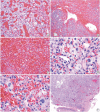Neuropathologic features of central nervous system hemangioblastoma
- PMID: 35501672
- PMCID: PMC9119802
- DOI: 10.4132/jptm.2022.04.13
Neuropathologic features of central nervous system hemangioblastoma
Abstract
Hemangioblastoma is a benign, highly vascularized neoplasm of the central nervous system (CNS). This tumor is associated with loss of function of the VHL gene and demonstrates frequent occurrence in von Hippel-Lindau (VHL) disease. While this entity is designated CNS World Health Organization grade 1, due to its predilection for the cerebellum, brainstem, and spinal cord, it is still an important cause of morbidity and mortality in affected patients. Recognition and accurate diagnosis of hemangioblastoma is essential for the practice of surgical neuropathology. Other CNS neoplasms, including several tumors associated with VHL disease, may present as histologic mimics, making diagnosis challenging. We outline key clinical and radiologic features, pathophysiology, treatment modalities, and prognostic information for hemangioblastoma, and provide a thorough review of the gross, microscopic, immunophenotypic, and molecular features used to guide diagnosis.
Keywords: Brain; Cerebellar neoplasms; Hemangioblastoma; Neuropathology; von Hippel-Lindau disease.
Conflict of interest statement
The authors declare that they have no potential conflicts of interest.
Figures




References
-
- Tse JY, Wong JH, Lo KW, Poon WS, Huang DP, Ng HK. Molecular genetic analysis of the von Hippel-Lindau disease tumor suppressor gene in familial and sporadic cerebellar hemangioblastomas. Am J Clin Pathol. 1997;107:459–66. - PubMed
-
- WHO Classification of Tumours Editorial Board . Lyon: International Agency for Research on Cancer; 2021. Central nervous system tumours. 5th ed. Vol. 6 [Internet] [cited 2022 Mar 10]. Available from: https://tumourclassification.iarc.who.int/chapters/45.
Publication types
Grants and funding
LinkOut - more resources
Full Text Sources

